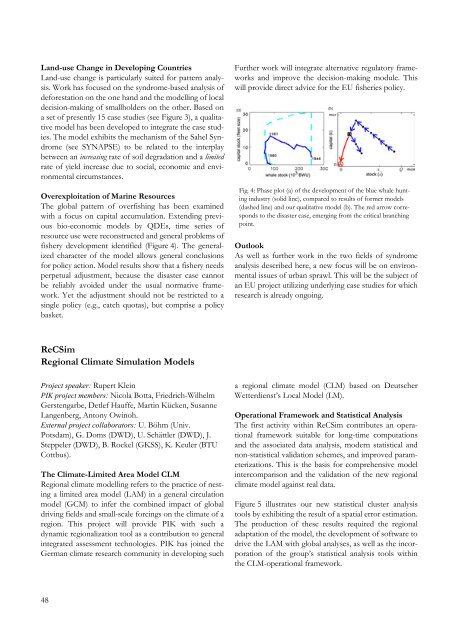PIK Biennial Report 2000-2001 - Potsdam Institute for Climate ...
PIK Biennial Report 2000-2001 - Potsdam Institute for Climate ...
PIK Biennial Report 2000-2001 - Potsdam Institute for Climate ...
You also want an ePaper? Increase the reach of your titles
YUMPU automatically turns print PDFs into web optimized ePapers that Google loves.
Land-use Change in Developing Countries<br />
Land-use change is particularly suited <strong>for</strong> pattern analysis.<br />
Work has focused on the syndrome-based analysis of<br />
de<strong>for</strong>estation on the one hand and the modelling of local<br />
decision-making of smallholders on the other. Based on<br />
a set of presently 15 case studies (see Figure 3), a qualitative<br />
model has been developed to integrate the case studies.<br />
The model exhibits the mechanism of the Sahel Syndrome<br />
(see SYNAPSE) to be related to the interplay<br />
between an increasing rate of soil degradation and a limited<br />
rate of yield increase due to social, economic and environmental<br />
circumstances.<br />
Overexploitation of Marine Resources<br />
The global pattern of overfishing has been examined<br />
with a focus on capital accumulation. Extending previous<br />
bio-economic models by QDEs, time series of<br />
resource use were reconstructed and general problems of<br />
fishery development identified (Figure 4). The generalized<br />
character of the model allows general conclusions<br />
<strong>for</strong> policy action. Model results show that a fishery needs<br />
perpetual adjustment, because the disaster case cannot<br />
be reliably avoided under the usual normative framework.<br />
Yet the adjustment should not be restricted to a<br />
single policy (e.g., catch quotas), but comprise a policy<br />
basket.<br />
ReCSim<br />
Regional <strong>Climate</strong> Simulation Models<br />
Project speaker: Rupert Klein<br />
<strong>PIK</strong> project members: Nicola Botta, Friedrich-Wilhelm<br />
Gerstengarbe, Detlef Hauffe, Martin Kücken, Susanne<br />
Langenberg, Antony Owinoh.<br />
External project collaborators: U. Böhm (Univ.<br />
<strong>Potsdam</strong>), G. Doms (DWD), U. Schättler (DWD), J.<br />
Steppeler (DWD), B. Rockel (GKSS), K. Keuler (BTU<br />
Cottbus).<br />
The <strong>Climate</strong>-Limited Area Model CLM<br />
Regional climate modelling refers to the practice of nesting<br />
a limited area model (LAM) in a general circulation<br />
model (GCM) to infer the combined impact of global<br />
driving fields and small-scale <strong>for</strong>cings on the climate of a<br />
region. This project will provide <strong>PIK</strong> with such a<br />
dynamic regionalization tool as a contribution to general<br />
integrated assessment technologies. <strong>PIK</strong> has joined the<br />
German climate research community in developing such<br />
48<br />
Further work will integrate alternative regulatory frameworks<br />
and improve the decision-making module. This<br />
will provide direct advice <strong>for</strong> the EU fisheries policy.<br />
Fig. 4: Phase plot (a) of the development of the blue whale hunting<br />
industry (solid line), compared to results of <strong>for</strong>mer models<br />
(dashed line) and our qualitative model (b). The red arrow corresponds<br />
to the disaster case, emerging from the critical branching<br />
point.<br />
Outlook<br />
As well as further work in the two fields of syndrome<br />
analysis described here, a new focus will be on environmental<br />
issues of urban sprawl. This will be the subject of<br />
an EU project utilizing underlying case studies <strong>for</strong> which<br />
research is already ongoing.<br />
a regional climate model (CLM) based on Deutscher<br />
Wetterdienst’s Local Model (LM).<br />
Operational Framework and Statistical Analysis<br />
The first activity within ReCSim contributes an operational<br />
framework suitable <strong>for</strong> long-time computations<br />
and the associated data analysis, modern statistical and<br />
non-statistical validation schemes, and improved parameterizations.<br />
This is the basis <strong>for</strong> comprehensive model<br />
intercomparison and the validation of the new regional<br />
climate model against real data.<br />
Figure 5 illustrates our new statistical cluster analysis<br />
tools by exhibiting the result of a spatial error estimation.<br />
The production of these results required the regional<br />
adaptation of the model, the development of software to<br />
drive the LAM with global analyses, as well as the incorporation<br />
of the group’s statistical analysis tools within<br />
the CLM-operational framework.

















